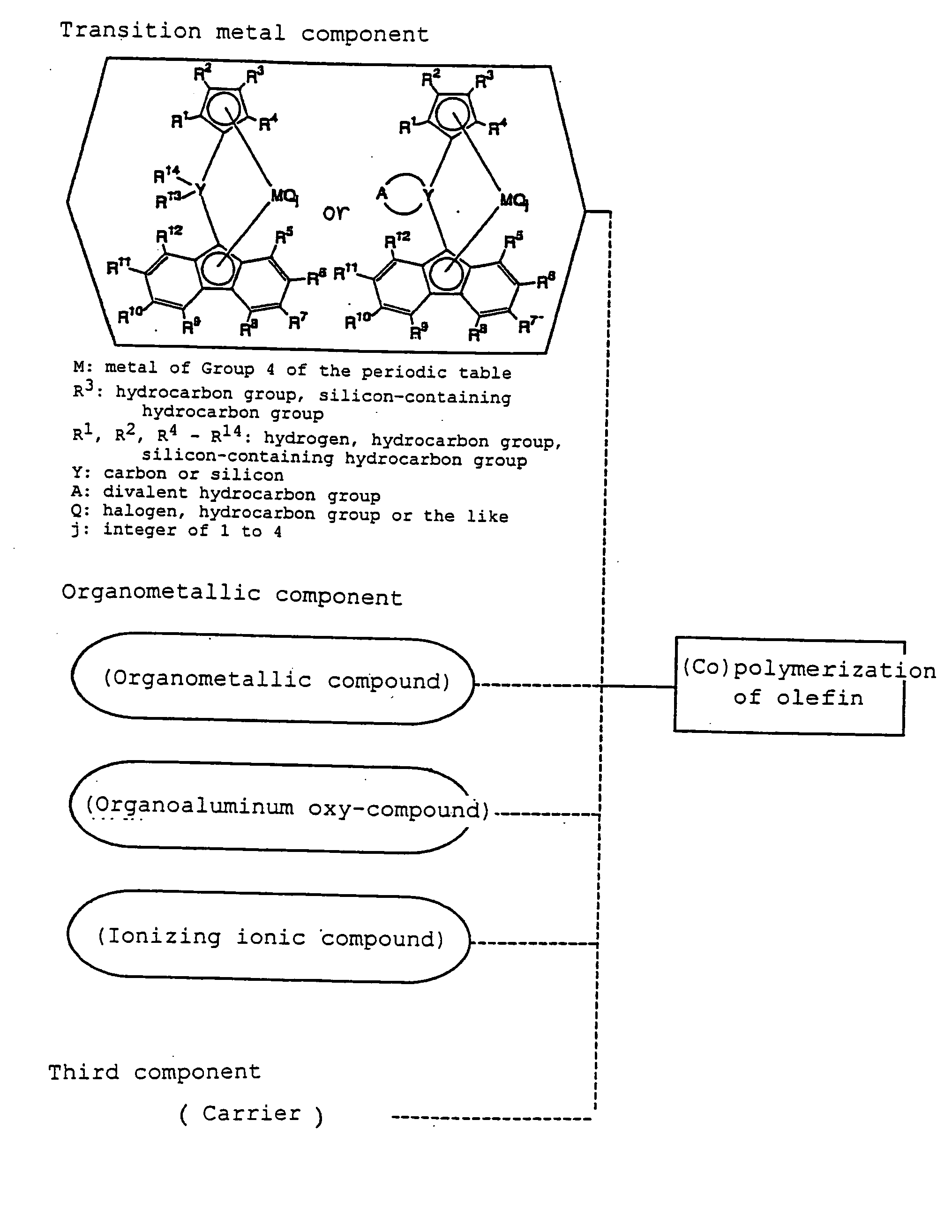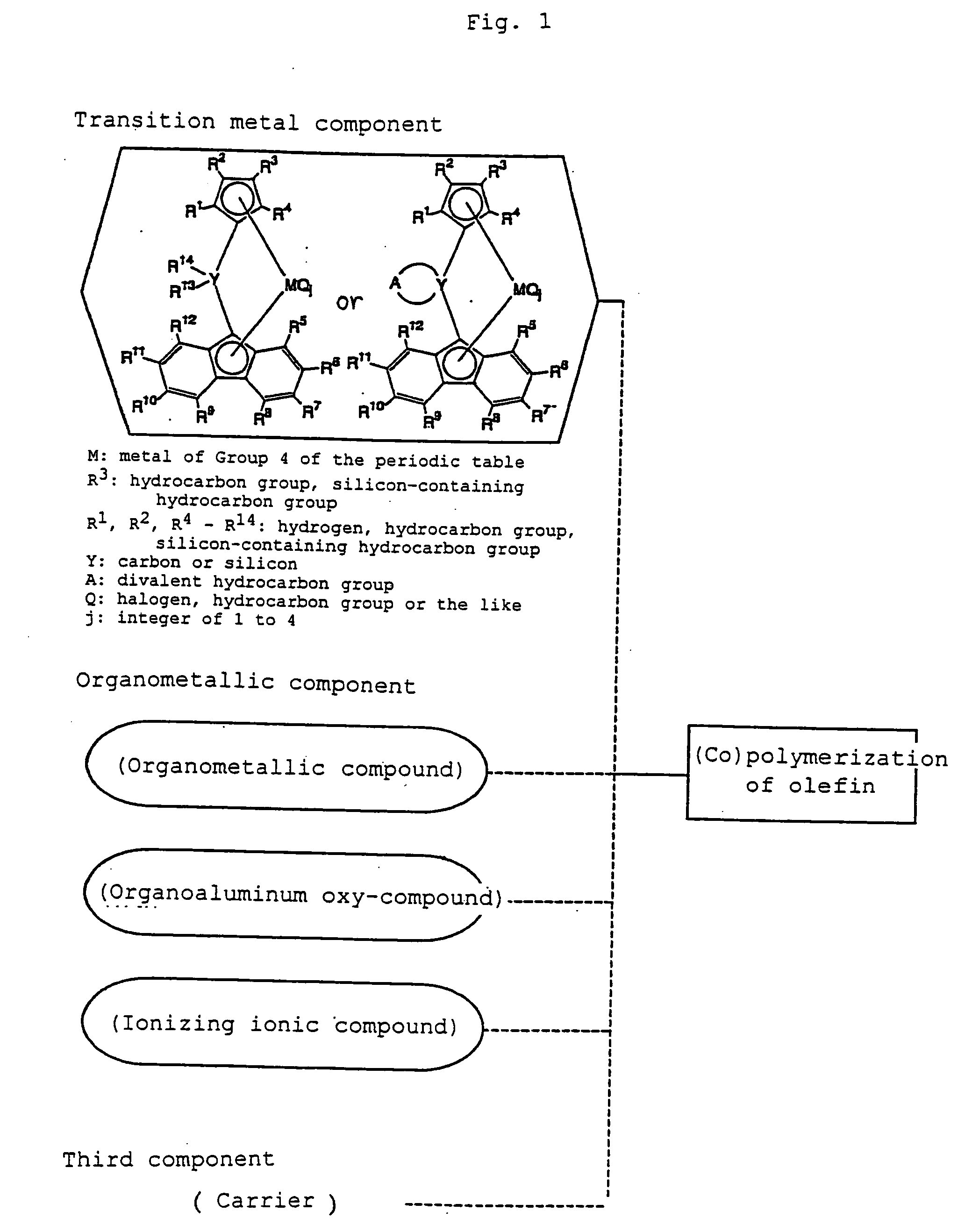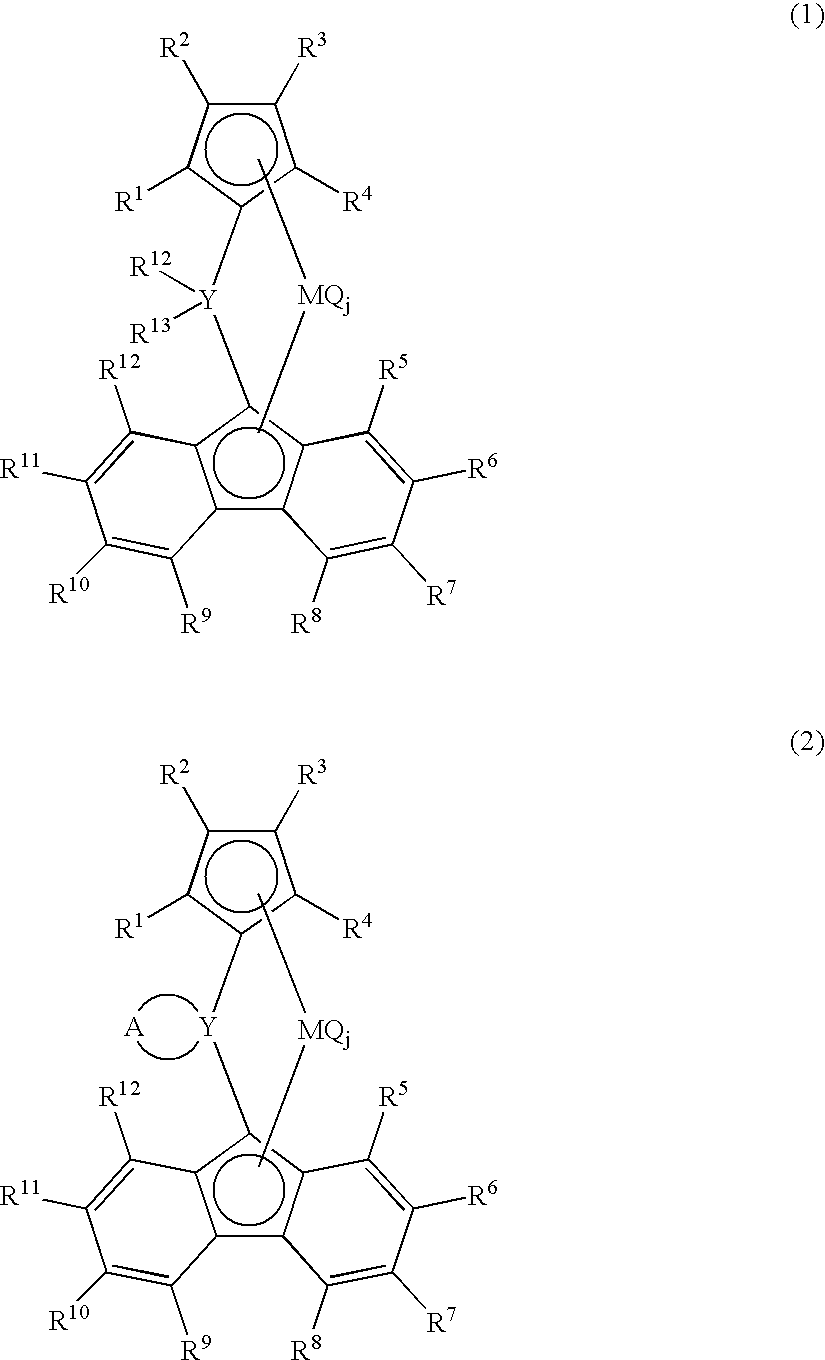Metallocene compound, process for preparing metallocene compund, olefin polymerization catalyst, process for preparing polyolefin, and polyolefin
a technology of olefin polymerization catalyst and metallocene compound, which is applied in the field of metallocene compound, can solve the problems of insufficient polymerization activity bringing about unnecessary isomers, and reducing the polymerization efficiency of these metallocene compounds
- Summary
- Abstract
- Description
- Claims
- Application Information
AI Technical Summary
Benefits of technology
Problems solved by technology
Method used
Image
Examples
example 1
Synthesis of dimethylmethylene(3-tert-butyl-5-methylcyclopentadienyl)fluorenylzirconium dichloride
(1) Synthesis of 1-tert-butyl-3-methylcyclopentadiene
[0377] To a solution obtained by adding 350 ml of dehydrated diethyl ether to 450 ml (0.90 mol) of a tert-butylmagnesium chloride / diethyl ether solution (concentration: 2.0 mol / liter), a solution of 43.7 g (0.45 mmol) of 3-methylcyclopentenone in 150 ml of dehydrated diethyl ether was dropwise added in a nitrogen atmosphere at 0° C. with ice cooling, followed by stirring at room temperature for 15 hours. To the reaction solution, a solution of 80.0 g (1.50 mol) of ammonium chloride in 350 ml of water was dropwise added at 0° C. with ice cooling. To the resulting solution, 2500 ml of water was added, followed by stirring. Then, the organic phase was separated and washed with water. To the organic phase, 82 ml of a 10% hydrochloric acid aqueous solution was added at 0° C. with ice cooling, followed by stirring at room temperature for ...
example 2
Synthesis of cyclohexylidene(3-tert-butyl-5-methylcyclopentadienyl)fluorenylzirconium dichloride
(1) Synthesis of 3-tert-butyl-5-methyl-6,6-pentamethylenefulvene
[0386] To 50 ml of dehydrated methanol, 0.5 g (3.68 mmol) of 1-tert-butyl-3-methylcyclopentadiene and 3.81 ml (36.8 mmol) of cyclohexanone were added, then 3.07 ml (36.8 mmol) of pyrrolidine was dropwise added at 0° C., and the mixture was reacted at room temperature for 7 days. Then, 20 ml of water was added at 0° C. After extraction with ether, the organic phase was washed with water and successively dried over anhydrous magnesium sulfate. Then, the solvent was distilled off to obtain 1.3 g of a light yellow solid. The analyzed values are given below.
[0387]1H-NMR (270 MHz, in CDCl3, Based on TMS): δ 6.26 (s, 1H), 6.10 (s, 1H), 2.71 (dd, 2H), 2.61 (dd, 2H), 2.27 (d, 3H), 1.80-1.61 (m, 6H), 1.17 (s, 9H)
(2) Synthesis of 1-(3-tert-butyl-5-methylcyclopentadienyl)-1-fluorenylcyclohexane
[0388] To a solution of 0.8 g (4.5 mmol...
example 3
Synthesis of dimethylmethylene(3-tert-butyl-5-methylcyclopentadienyl)(3,6-di-tert-butylfluorenyl)zirconium dichloride
(1) Synthesis of 2-(3-tert-butyl-5-methylcyclopentadienyl)-2-(3,6-di-tert-butylfluorenyl)propane
[0396] To a solution of 0.9 g (3.4 mmol) of 3,6-di-tert-butylfluorene in 30 ml of THF, 2.1 ml (3.4 mmol) of a hexane solution of n-butyllithium was dropwise added in a nitrogen atmosphere with ice cooling, followed by stirring at room temperature for 6 hours. To the resulting red solution, a solution of 0.6 g (3.5 mmol) of 3-tert-butyl-5,6,6-trimethylfulvene in 15 ml of THF was dropwise added in a nitrogen atmosphere with ice cooling, followed by stirring at room temperature for 12 hours. Then, 30 ml of water was added. The organic phase extracted with diethyl ether and separated was dried over magnesium sulfate and then filtered. From the filtrate, the solvent was removed under reduced pressure to obtain a solid. The solid was recrystallized from hot methanol to obtain 1...
PUM
| Property | Measurement | Unit |
|---|---|---|
| molecular weight distribution | aaaaa | aaaaa |
| Tm | aaaaa | aaaaa |
| Tm | aaaaa | aaaaa |
Abstract
Description
Claims
Application Information
 Login to View More
Login to View More - R&D
- Intellectual Property
- Life Sciences
- Materials
- Tech Scout
- Unparalleled Data Quality
- Higher Quality Content
- 60% Fewer Hallucinations
Browse by: Latest US Patents, China's latest patents, Technical Efficacy Thesaurus, Application Domain, Technology Topic, Popular Technical Reports.
© 2025 PatSnap. All rights reserved.Legal|Privacy policy|Modern Slavery Act Transparency Statement|Sitemap|About US| Contact US: help@patsnap.com



